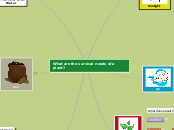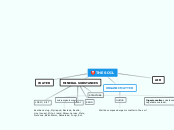SVN3M | Environmental Science 2020-2021 Course Summary 🌳
Human Health & The Environment
Approaches to Manage Water
Wetlands
Solar Ovens
LifeSaver Bottle
UV Water Sterilization
Earth Observation (EO) satellites
Organisms
Organism Overgrowth & Water Pollution
Attack an organism’s nervous system
Shellfish can cause serious illness
Produce toxins
Eutrophication
Phosphorus & nitrogen
Organisms Magnify Water Pollutants
Sharks, fish-eating birds, and humans
Biomagnification
Consume a lot of prey
Bioaccumulation
Phytoplankton & bacteria
Organic chemicals are resistant to degradation
Factors affecting water quality
Pathogens causing cholera, typhoid fever, hepatitis, & polio
Bacteria, viruses, and parasites endangering human health
Gastrointestinal diseases that produce toxins
Cause diseases (Celiac disease, etc.)
Bacteria carries out beneficial processes (Breaking down of organic wastes, etc.)
Purpose of water
Recreation & Beauty
Transportation
Manufacturing
Health & Hygiene
Shelter and Energy
Water lifecycle
Provides life-sustaining chemical reactions
Fills cells and supports their structure
Organisms contain over 50% liquid water
Makes life on Earth possible
Gas, solid and liquid in Earth’s atmosphere
Pollution Sources & Solution
Non-point pollution
Source cnnot be pinpointed
Point pollution
Source can be pinpointed
Canadian cans of fresh air
Motor Vehicle Emissions
Sick building syndrome (SBS)
Collection of illnesses from poor air quality
Indoor air pollution
Radon gas
Bacteria
Moulds (fungi)
Asbestos
Photochemical smog
Reduced visibility & high oxidant levels
Sulphurous smog
Cool weather, coal burning
Earth
Atmosphere
5 atmospheric layers
TROPOSPHERE
STRATOSPHERE
MESOSPHERE
THERMOSPHERE
EXOSPHERE
Oxygen and nitrogen.
Layers of gases
Blanket of air surrounding Earth
Canadian Government Initatives | Improving Air Quality
Particulate Matter Emissions
Canadian Ambient Air Quality Standards
New air quality guidelines (Federal, provincial & municipal governments)
Power Plant Emissions
Effective for removing oxides
Catalytic converters
Converts pollutants into harmless substances
Industries & Emission Reductions
Reduced amount of VOCs from gas tanks and crankcase
Technology, Legislation, & Emissions Reductions
Limit emissions from manufacturing plants and products
Canadian Environmental Protection Act, 1999
Sustainable Agriculture & Forestry
Sustainable meat production
Organic farming + wild species
Polycultures
Rotational grazing
Smart Pasture Operations
Pest Management
Controls pest poulatuion
Biological organisms
Chemical substances crop rotation
Soil conservation
Maintains soil fertility
Green manure
Mulch
Compost
Crop rotation
Perserves soil nutrients
Diversification of crops
Reduces soil errosion
Strip Cropping
Polyculture
Methods
Companion planting
Squash
Beans
Corns
Diverse species
Sustainable agriculture
With no compromises
Genetically Modified Crops
Purpose
Aesthetics
Improve crops
Virus resistance
Herbicide resistance
Insect resistance
DNA from any source
Inserting modified DNA into an organism
Irrigation
Types
Drip irrigation
Spray irrigation
Surface irrigation
Amounts vary in each country
70% of water consumption
Synthetic Pesticides
Effects on Ecosystems
Resistance
Animals
Plants
Fungi
Synthetic fertilizers
Concerns
Algal blooms leading to fish kills
Impact on aquatic ecosystems
Potassium
Monoculture
Attractive to farmers
Saame species
Growth of a single crop
Sustainable forestry
Value ecosystem services
Certify sustainably managed forests
Regenerate after harvesting
Leave Organic Matter in place
Harvest timber sustainably
Protect biodiversity
Silviculture Methods
Types of Clearcutting
Shelterwood System
Selective Cutting
Clear cutting
Removal of trees
Harvest timber & regenerate trees
Condition of the site
Age of the trees
Tree species
Development & management of forests
Roles & Services
Forestry contribution to ecosystem
Non-timber resources
Tourism
Craft & wood-carving
Medicine & personal care products
Food
Timber resources
Provide habitats
Water purification
Cycle nutrients
Phosphorus
Nitrogen
Carbon
Store carbon
Reduce soil erosion
Forest management
Basic structures
Abiotic & Biotic factors
Forest Floor
Understory
Canopy
Tropical
Temperate
Deciduous
Boreal
Canada’s forests make up 10% of
world forests
Trees dominate ecosystem
Gardening/farming
Arts
Furniture selling
Landscaping/deck building
Forestry management
Soil
Soil properties
pH
Porosity
Texture
Layers of soil
Living organisms
Worms, insects, soil bacteria & fungi
Breaks down nutrients
Humus
Topsoil
Roots
Nutrients
Profile
Soil components
4 main components
Organic material
Water
Air
Mineral matter
Tardigrade
Nature's smallest animal
Urban forests & green roof
Insulation
Heat absorption
Cooling from evaporation
Shade
Heat island effect
Urban forestry
Urban environments
Long-term planning
CO2 Interference
Photosynthesis ceases
Range of temperatures
Determines optimal performance
Tropical forests
28 degrees C
Temperate forests
18 degrees C
Temperature thresholds
Trees expel unusually more CO2
Increasing temperatures
No sunlight
Reducing & Managing Waste
Waste-free & Plastic free Lifestyle
Bidet
Invented in France
Popular in Italy, Portugal, Japan, Argentina, and Venezuela
Trash fashion
Liquid-waste management
Treating sweage
Treating Storm Water
Municipal Sewage Treatment
Septic systems
Sewage water
Stirn water
Wastewater
Industry
Agriculture
Household
Solid-waste management
Control measures
Managing waste
Recycling
Pollution prevention act
Disposal of Solid Waste
Recycle
Repair
Refuse, reduce and reuse
Reduction at source
Composting
Incineration
Ocean dumping
Landfills
Open dumping
Transportation of Solid Waste
Collection of soild waste
Rag pickers
By city municipality
Effects of solid waste
Reduces aesthetic value
Causing water pollution
Disease-causing organisms
Solid waste classification
Mining waste
Hospital waste
Metal waste
Plastic waste
Liquid waste
E-waste
Solid waste
Land-waste management
Land-pollution and solid waste management
Controlling land pollution
branches
Biodegradable wastes
Branches
Leaves
Yard clippings
Reducing volume
Bioremediation
Ex situ bioremediation:
In situ Bioremediation
Hazards from waste
Nuclear waste
Hazardous waste
Municipal sold waste
Man-made causes
Radioactive wastes
Domestic waste & garbage
Agriculture waste
Mining
Urbanization
Industrial waste
Types of soil pollutants
Cadmium
Lead
Pesticides, fertilizers and other agricultural Products
Dioxins
Heavy Metals
Conservation Energy
Uranium & nuclear energy
Fission
Thermal energy
Trans mountain pipeline
Indigenous ownership key to reconciling oil industry
Energy Consumption
Fracking
Fracking in Canada
Triggers earthquakes
Under moderation due to Geology
General information
Chemicals (0.5%)
Sand (9.5%)
Water (90%)
Shale to fracture
High pressure
Pumping fluid
Classifying energy resources
Renewables
Wave & tidal
Wave energy
Heat engines
Domestic Tidal Power
Tidal turbines
Accumulate potential energy
Barrages
Low tide
High tide
Biomass
Types of biofuels
Biodiesel
Ethanol
Organic material from plants and animals
Geothermal
Types of plants
Binary Power Plants
Flash Steam Plants
Dry Steam Plants
Geothermal Heat Pumps
Electricity Generation
Ocean Thermal Energy Conversion
Ring of fire
Renewable
Heat from Earth
Hydro
Niagara falls
Generators
Turbines
Dams
Accelerated by gravity
Wind
Wind farm
Kinetic energy
Solar
Subtopic
Passive, active & photovoltaic collection
Produced by sun
Non-renewable
Alberta oil sands controversy
10% of it is economically recoverable
1.7 trillion barrels of oil
Worlds largest and accessible oil sands reserve
Coated in bitumen
Natural Gas
Arctic permafrost
Trapped within crystals of frozen water
Trapped above oil deposits
Hydraulic fracturing
Oil
Ways that oil is extracted
Extraction via SAGD
Mining & steam
Dangers of oil extraction
Aquatic organisms and birds harmed
Tanker leaks
Also known as reserviors
Coal
Dangers of coal mining
Air pollution
Land degradation
Water pollution
Dangerous occupation
Ways that coal is mined
Underground mining
Surface mining
Fossil fuels
Not expensive
Concentrated sources of chemical energy
Uranium
Provides energy to allow movement









